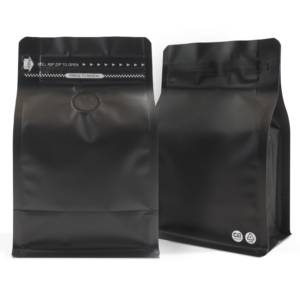Imagine a typical morning in a coffee roastery. The aroma of freshly roasted beans fills the air, signalling the start of a new batch. But beyond the roasting lies a critical decision – choosing the right packaging. This choice is more than practical; it’s about preserving the coffee while honoring the planet. In this article, we’ll explore the intricate balance between preserving coffee quality and embracing sustainability in packaging, a journey that coffee roasters navigate daily.
The Critical Role of Packaging in Coffee Quality
The journey of coffee from roaster to cup is laden with challenges, the most formidable being maintaining its quality. Packaging plays a pivotal role here. According to a study by the National Coffee Association, appropriate packaging can extend the shelf life of coffee by several months, preserving its aroma and flavor. This isn’t just about keeping coffee fresh; it’s about delivering an experience that consumers expect with every sip.
Exploring Different Packaging Materials
In the world of coffee packaging, diversity reigns. From the traditional foil-lined bags to modern biodegradable materials, each comes with its set of benefits. Foil, for instance, is excellent for blocking out moisture and oxygen, while newer materials like PLA (polylactic acid) offer similar protection with the added benefit of being compostable. This variety allows roasters to choose packaging that aligns with both their quality standards and environmental values.
Sustainability in Coffee Packaging
Sustainability in packaging is no longer a niche trend but a global movement. A report by the Specialty Coffee Association highlights an increasing consumer demand for eco-friendly packaging. This shift isn’t just about reducing waste; it’s about reflecting a brand’s commitment to environmental stewardship. Materials like recycled paper and bioplastics are becoming popular choices, offering a reduced carbon footprint without compromising on quality.
The Shift Towards Compostable Packaging
Compostable packaging is a beacon of hope in balancing quality and sustainability. It’s designed to break down in a compost environment, leaving no harmful residues. This not only reduces landfill waste but also contributes to a healthier ecosystem. The Bag Broker Australia, for instance, offers compostable packaging options that cater to the needs of environmentally conscious coffee roasters, ensuring that their product remains fresh and their footprint, minimal.
Recyclable Level 4 Packaging: A Game Changer
Level 4 recyclable packaging is revolutionizing the coffee industry. It’s designed to withstand the rigors of recycling processes, making it a sustainable choice for roasters. This type of packaging not only supports environmental initiatives but also meets the stringent quality requirements necessary for preserving coffee.
The Rise of Post-Consumer Recycled Packaging
Post-consumer recycled (PCR) packaging is gaining momentum. It’s made from recycled materials, giving a second life to previously used plastics and papers. This approach not only reduces the demand for virgin materials but also demonstrates a commitment to circular economy principles, something that The Bag Broker Australia proudly supports through their range of PCR packaging options.
Carbon Neutral Packaging: Leading the Way
Carbon-neutral packaging is the pinnacle of sustainable packaging efforts. It involves offsetting the carbon footprint generated during the production and distribution of packaging. The Bag Broker Australia, as a carbon-neutral packaging supplier, exemplifies this commitment, helping coffee roasters reduce their environmental impact and appeal to eco-conscious consumers.
Balancing Quality with Eco-Friendly Practices
The challenge for coffee roasters is finding the balance between preserving the quality of their coffee and adopting eco-friendly packaging practices. This balance requires a careful selection of materials, considering factors like barrier properties, durability, and environmental impact. It’s a delicate dance, but one that can lead to a harmonious blend of quality and sustainability.
The Bag Broker Australia: A Partner in Quality and Sustainability
The Bag Broker Australia stands out as a key ally for coffee roasters in this journey. Their range of compostable, recyclable, and PCR packaging solutions cater to the diverse needs of roasters who prioritize both quality and sustainability. By choosing The Bag Broker Australia, roasters can ensure their coffee is not only fresh and flavorful but also packaged with the planet in mind.
The Economic Perspective: Cost vs. Benefit
Investing in sustainable packaging is an economic decision as much as it is an environmental one. While the initial costs might be higher, the long-term benefits – in terms of brand loyalty, customer satisfaction, and environmental impact – can outweigh the investment. Roasters find that consumers are often willing to pay a premium for products that align with their values, making sustainable packaging a wise investment.
Consumer Perceptions of Sustainable Coffee Packaging
Consumer perception is a critical factor in packaging decisions. A survey by the National Retail Federation found that a significant percentage of consumers prefer to buy products with sustainable packaging. This trend is particularly pronounced among younger demographics, indicating a shifting market that values environmental responsibility.
The Future of Coffee Packaging
The future of coffee packaging is one of innovation and sustainability. Emerging trends like smart packaging, which includes QR codes and augmented reality, are set to transform how consumers interact with products. At the same time, advancements in sustainable materials will continue to push the boundaries of what’s possible in eco-friendly packaging.
It’s clear that the choice of coffee packaging is a complex interplay of quality preservation, environmental responsibility, and consumer perception. For coffee roasters, each packaging decision is an opportunity to make a positive impact. As we embrace a future where sustainability is not just a choice but a necessity, it’s worth asking: How will your packaging choices shape your legacy in the world of coffee?



